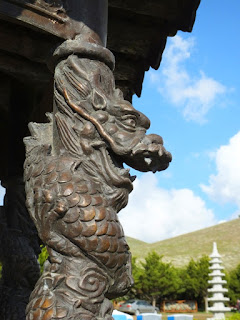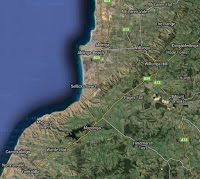 |
| Guan Yin, the Chinese Goddess of Mercy, gazes west over the sea at Nan Hai Pu Tuo |
 |
The Guan Yin statue at Nan Hai Pu Tuo was crafted in China and shipped to
Australia in pieces for assembly at the temple at Sellicks Beach. |
 |
| Guan Yin will be the centerpiece of a massive temple which will take years more to complete... |
 |
| Nan Hai Pu Tuo, the Chinese Buddhist temple, stands on the Gulf St. Vincent, in South Australia |
 |
The temple is open to the public, though the buildings are still temporary. Work continues, and we visit
every few months to watch the progress. |
 |
| Here, the 20 meter Guan Yin statue is in place, presiding over earth-moving machines... |
 |
Statues and art at Nan Hai Pu Tuo were shipped from workshops in China over the space of a year or more,
and stored on-site, waiting to be set into place. |
 |
The Chinese Buddhist temple at Sellicks Beach attracts many visitors, some who come for devotions, others
who come for the art and the tranquility. |
 |
| Behind Nan Hai Pu Tuo, the land rises away in the Fleurieu Peninsula's gentle hills. Sheep graze these paddocks... |
 |
| Looking north from the clifftop on a cloudy day. The suburbs of Adelaide sprawls into the mist. |
 |
| The cliffs at Sellicks Beach on a sunny summer day -- looking south toward Carrickalinga and Normanville. |
 |
The address of Nan Hai Pu Tuo is 'Cactus Canyon Road' ...and here's why! Yep, there's cactuses. Not sure
the location qualifies as a 'canyon' in the US sense. More a weather-worn crevice in the cliffs. |
 |
| Guan Yun, Chinese Goddess of Mercy, at Nan Hai Pu Tuo, Sellicks Beach. |
 |
| Guan Yun gazes over the Gulf St. Vincent, on the Fleurieu Peninsula, South Australia. |
 |
| Detail from the headdress of the Guan Yin statue: Gautama perhaps. |
 |
Chinese historical design enriches the entire temple site. A visit to Nan Hai Pu Tuo is like stepping into a living
art gallery or museum. In another year the meditation gardens should be open. |
Above: as you stroll around the grounds, be sure to look down as well as up. Some of the most gorgeous artwork is at your feet, much in the Chinese historical form, and some -- like the detail of a ram's head from a great bronze vessel, above right -- in the very ancient form, from a time when most of Europe was in its pre-historic phase.
Below: a six-inch New Holland honey eater chases tiny insects in the blooms of a twenty-foot cactus flower, and a potted succulent in the grounds of Nan Hai Pu Tuo temple produces tiny flowers in amazing shades of pink.
 |
| The great bronze urns are filled with sand -- incense sticks burn here... |
 |
Fantastic animals, part dragon and part turtle, form the footers for the monolithic temple stones bearing
Buddhist inscriptions in Chinese. No English translation is provided, alas. |
 |
Guan Yin is surrounded by temple stones, supported by fantastical creates and
topped by writhing dragons (see below). At her feet is an altar bearing fruit and flowers.
Nan Hai Pu Tuo has been serving as a functional temple since around 2014. |
Above: the temple stones, standing three or four meters high, are inscribed with texts one assumes are sutras, prayers or memorials. We wished an English translation had been provided, but alas, all at Nan Hai Pu Tuo is in Chinese, save for a notice saying 'No cameras in the temple, thank you.' (Entirely understandable. The outdoor arena where Guan Yin stands can be photographed. Jade
was hesitant, till noticing Chinese tourists had no such hesitation to photograph.)
 |
| Visit Nan Hai Pu Tuo in the dead of winter: the hills are green, dotted with sheep and growing gold with sour sobs. |
 |
| Winter skies mist the hills at Sellicks Beach, where Guan Yin gazes west to the sea... |
 |
...and Nan Hai Pu Tuo probably has mouse issues! In recent months we see a new arrival --
the friendliest young cat whose role would be understood by felines the world over. |
 |
The Nan Hai Pu Tuo temple cat is still very young ... his paws are enormous, and when he's full grown
he should be the size of a lion cub. Purrrrr. Just one more scitch! |
A few minutes' drive out of the Adelaide southern suburbs brings you into Sellicks Beach on Aldinga Bay. (The thumbnail map at left is perfectly readable, if you view full size.) You leave behind the bustle of Noarlunga Centre and the new developments and head into sheep grazing country ... green hills and mist, in winter, brown and sun-scorched in summer.
And just as you pass the town of Sellicks Beach, you see a flash of white popping up beyond the southern hills. Did you imagine it? Take another look. You're catching sight of the very top of the twenty meter statue of Guan Yin, the Chinese Goddess of Mercy, which stands gazing west over the ocean at Nan Hai Pu Tuo, the Chinese Buddhist temple at Sellicks Beach, on the coast of South Australis's Fleurieu Peninsula.
The local popular press made the usual, even predictable mistake, when the statue was raised from hundreds of blocks shipped from a workshop in China. They promptly called it 'the Buddha statue.' Well, their hearts were in the right place, at least! (
Bodhisattva would actually be spot on; but doubtlessly it's way too hard to spell...) Even a cursory glance will show you this is not a likeness of Gautama, or any of the other numerous historical buddhas.
In fact, the Guan Yin statue rising high above the coast of the Gulf St. Vincent is the
second such statue in the world. The other is the Guan Yin of the South Sea of Sanya, in the province of Hainan, in China -- see its
Wikipedia page right here. Our statue isn't so tall, but it's extremely beautiful. It forms the focus of a Chinese Buddhist temple right in the heart of Australia, which, when completed, will have taken over ten
years to build.
At this time work is still in progress, but the gardens are growing in and much of the statuary is in place. The meditation gardens should be ready in another year or two, and work on the permanent temple and pagoda should begin soon. In mid-2016, temporary structures are still serving as temple and refectory; and photography is -- understandably --
not allowed inside the temple. We can't show you the interior, with its glorious states and immense bronze bell. In fact, Jade was somewhat hesitant to take photos at all, until she noticed that Chinese tourists visiting the area has no such hesitation.
Save for a sign saying, 'No photography in the temple, thank you,' here isn't a word of English anywhere at Nan Hai Pu Tuo. We wish there were. Europeans have one devil of a time learning to recognize Chinese characters -- it takes a lifetime. Note to temple staff: English signs, please?
We've visited in summer and winter alike, every few months, to watch the progress. Can't wait for the meditation gardens to be open to the public. It's going to be peace on Earth, and Jade is looking forward to taking an hour to drift away on a cloud of tranquility there. Better than a pill.
There is a website for Nan Hai Pu Tuo, but it looks like it hasn't been updated in nine years, and there's very little on it:
http://nanhaiputuotemple.com ... hopefully they'll rework this soon.
Visit Nan Hai Pu Tuo on your way south to Second Valley and Rapid Bay, Goolwa and Victor Harbour. Or, swing inland at Aldinga and visit Myponga Reservoir on the way to a picnic at Mount Compass.
















































































